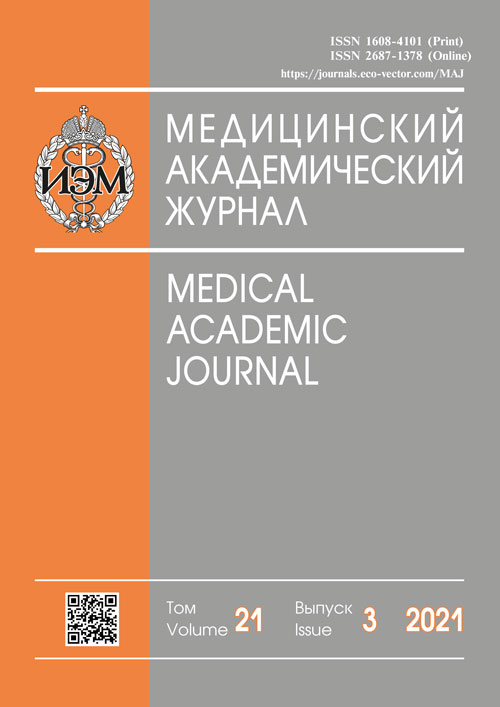Etiology of severe acute respiratory infections in Ekaterinburg in different epidemic seasons
- Authors: Lelenkova E.V.1, Markaryan A.Y.1
-
Affiliations:
- Ekaterinburg Research Institute of Viral Infections, State Research Center of Virology and Biotechnology “Vector”
- Issue: Vol 21, No 3 (2021)
- Pages: 123-126
- Section: Conference proceedings
- Published: 06.12.2021
- URL: https://journals.eco-vector.com/MAJ/article/view/77286
- DOI: https://doi.org/10.17816/MAJ77286
- ID: 77286
Cite item
Abstract
BACKGROUND: Acute respiratory viral infections are ubiquitous. Part of the cases are severe and require hospital treatment.
AIM: Studying the etiology of severe acute respiratory infections in patients of Ekaterinburg hospitals in different epidemic seasons (from 2017 to 2020).
MATERIALS AND METHODS: 1,132 cases of severe acute respiratory infection were assessed. The structure of laboratory-confirmed cases was determined.
RESULTS: In the assessed seasons, the proportion of respiratory viruses in the etiological structure of severe acute respiratory infections was 56.0% on average. B/Yamagata lineage of influenza viruses was predominant in the season of 2017/2018 (23.9% from the total number of respiratory viruses), — influenza А (H1N1)pdm09 viruses were predominant in the season of 2018/2019 (27.7%), and influenza A and B viruses were identified in 2019/2020 (39.4% and 31.7%, respectively).
СONCLUSIONS: The obtained results confirm a key role of influenza viruses in the etiology of severe acute respiratory infections among the hospital patients in different epidemic seasons.
Full Text
About the authors
Evgeniya Viktorovna Lelenkova
Ekaterinburg Research Institute of Viral Infections, State Research Center of Virology and Biotechnology “Vector”
Author for correspondence.
Email: lelenkova_ev@eniivi.ru
ORCID iD: 0000-0003-2004-0977
SPIN-code: 2149-3650
Researcher of the Research Methodology Department, Epidemiologist
Russian Federation, EkaterinburgAlexandr Yurievich Markaryan
Ekaterinburg Research Institute of Viral Infections, State Research Center of Virology and Biotechnology “Vector”
Email: markaryan_ay@eniivi.ru
ORCID iD: 0000-0002-7286-6079
SPIN-code: 2081-9246
PhD (Biol.), Senior Researcher of the Laboratory of Respiratory Viral Infections
Russian Federation, EkaterinburgReferences
- Pisareva MM, Eder VA, Buzitskaya ZhV, et al. Etiological structure of influenza and other ARVI in St. Petersburg during epidemic seasons 2012–2016. Problems of Virology. 2018;63(5):233–239. (In Russ.) doi: 10.18821/0507-4088-2018-63-5-233-239
- Svistunova NV, Baranova IP, Zykova OA, Fedorova OV. A comparative analysis of clinical specificities of influenza A(H1N1) and influenza в in hospitalized patients. Infectious Diseases. 2013;11(1):27–32. (In Russ.)
- Svyatchenko SV, Durymanov AG, Susloparov IM, et al. Severe cases of seasonal influenza in Russia in 2015–2016 and 2016–2017. Journal of Microbiology, Epidemiology Immunobiology. 2018;(1):32–39. (In Russ.) doi: 10.36233/0372-9311-2018-1-32-39
- Meerhoff T, Simaku A, Ulqinaku D, et al. Surveillance for severe acute respiratory infections (SARI) in hospitals in the WHO European region – an exploratory analysis of risk factors for a severe outcome in influenza-positive SARI cases. BMC Infect Dis. 2015;15:1. doi: 10.1186/s12879-014-0722-x
- Rukovodstvo Evropeiskogo regional’nogo byuro VOZ po dozornomu ehpidnadzoru za grippom sredi lyudei [Internet]. WHO. 2011. (In Russ.) Available from: http://www.euro.who.int/data/assets/pdffile/0003/90444/e92738R.pdf. Accessed: 07.03.2021.
Supplementary files








